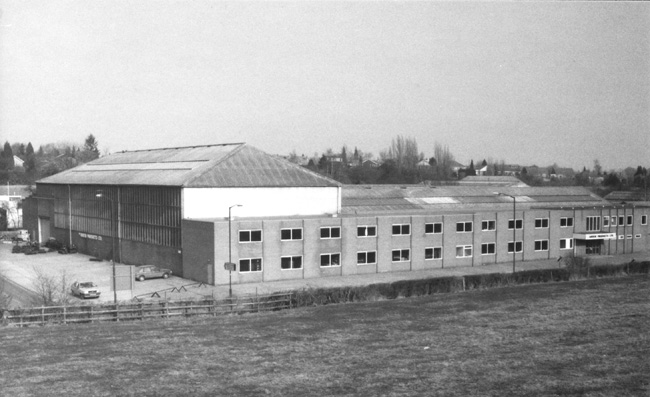Arden Products (Published in KWN, 7th December 2007)

Recently consigned to history after half a century, the Arden Products building seen in the mid-1980s. The field in the foreground is now Lulworth Park.
The 2008 transformation of the Arden Products site on the corner of Dalehouse Lane and Common Lane is symptomatic of the de-industrialisation of Kenilworth over the last 15 years or so. Large industrial sites at Moorlands Avenue, Mill End, Clarendon Road and behind the Methodist church in Priory Road have all succumbed to housing, but Arden Products was the largest and most recent.
Immediately after the Second World War, Lester Stickley was operating as a scrap metal merchant from the former fellmongers yard at Mill End (today it is Woodmill Meadow). Richard Hunter, who worked at Daimler but lived in Kenilworth, was looking for somewhere to start his own business. He asked Lester Stickley if any of the buildings on the site were usable; there was just one and Hunter agreed to rent the 15ft x 12ft room and Arden Products was in business. The firm’s first notable order was for 5,000 galvanised centres for cable spools.
Arden Products soon began to expand into other buildings that were renovated on the Common side of the brook. Seeing them in business tempted others to take over further buildings on the site and Kenilworth’s first industrial estate was born in a scrap yard.
Ardens soon began to outgrow their surroundings and so started a search for another site. Richard Hunter was offered the two-acre field on the corner of Common and Dalehouse Lanes; this had earlier been earmarked for industry – another Kenilworth firm, Veasey and Sharples, were offered it but instead moved to Coventry where they employed in excess of 200 people for several decades. Hunter however, accepted the offer. At this time, the eastern side of Common Lane was undeveloped save for a small engineering works on the northern side of the brook, and so the building of Arden Products was a major step in creating a new much needed estate for factories. So busy was the company at this time, particularly in work for Daimler, that Arden’s operated both sites for a while until the move to the new works was completed in 1952.
In its heyday, the 1970s, Ardens employed over 150, mostly Kenilworth, people in fabrication and sub-contract work. Although by the 1980s this had fallen to around 90, Ardens were for about 50 years a vital and important Kenilworth employer.
Once Arden’s was established, it was not long before other factories were built along Dalehouse Lane. OB Tools arrived in 1953 and even laid out a small garden at the front of their building. Unusually for a British firm, they made machine tools for the manufacture of intricate mechanisms, such as those in cameras and typewriters, which were more often associated with German companies. They were taken over by Ackworthie Machine Tool Limited in 1960, and in 1979 they in turn were acquired by Buckingham Vehicles who specialised in the making of tanker vehicles. The history of Buckingham’s is far too lengthy for this article but it was once a subsidiary of Eagle Engineering and was previously on the site now occupied by Sainsbury’s, hence the name Eagle Lane alongside the supermarket.
In between Ardens and Buckingham’s was once CWD Tools, another firm with its origins at Stickley’s scrapyard. This was on the site now occupied by the small units in Cotton Drive. It seems inevitable that now housing has been built on the Arden’s site that these industrial units, sandwiched between two extensive residential areas, will eventually become the subject of calls for their removal. Paradoxically, the new three-storey housing is more imposing than the factory building was as it is built right to the road’s edge; Ardens was set back from the road.
Read more of this subject in Kenilworth’s Engineering Age.